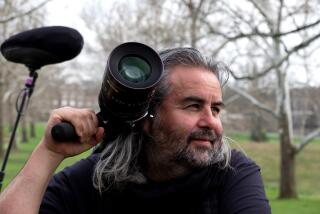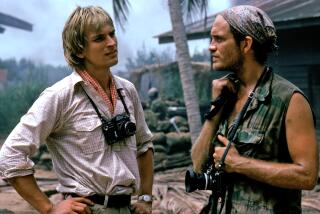Jack Cardiff dies at 94; Oscar-winning British cinematographer
- Share via
Jack Cardiff, the British cinematographer who won an Academy Award for his stunning color work on the 1947 drama “Black Narcissus” and later became an Oscar-nominated director, has died. He was 94.
Cardiff, who as a cinematographer was known as a pioneer of Technicolor and a “master of light,” died Wednesday of age-related causes at his home in Ely, England, said Craig McCall, the producer and director of a pending documentary on Cardiff.
“Jack was a great ambassador to film,” McCall said. “He loved it; it was his entire life and almost all the great people that we can mention crossed paths with him.”
Cardiff began as a child actor in silent movies and continued to remain professionally active until about three years ago, McCall said.
“He literally almost worked for 90 years, which is quite extraordinary in an industry that is just over a hundred years old.”
Once described by British director Michael Powell as “the greatest color cameraman in the world,” Cardiff was the cinematographer on films such as “The Red Shoes,” “The African Queen,” “The Barefoot Contessa,” “Under Capricorn,” “The Black Rose,” “The Magic Box,” “The Prince and the Showgirl” and “The Vikings.”
Among his later credits are “Death on the Nile,” “Conan the Destroyer” and “Rambo: First Blood Part II.”
In addition to his Oscar win for “Black Narcissus” -- the Powell and Emeric Pressburger-directed movie starring Deborah Kerr about a group of nuns who establish a remote mission in the Himalayas -- Cardiff earned Oscar nominations for his cinematography in 1957 for “War and Peace” and in 1962 for “Fanny.”
“He photographed several of the most beautiful Technicolor movies ever made,” film critic and historian Leonard Maltin told The Times on Wednesday. “I think ‘Black Narcissus’ is breathtaking, and that’s the one that always stands out in my mind.”
A director of 15 films, Cardiff also received an Oscar nomination for best director in 1961 for “Sons and Lovers,” an adaptation of the D.H. Lawrence novel starring Trevor Howard and Dean Stockwell.
But it was for his long career as a cinematographer that Cardiff remains best known, with Powell and Pressburger’s 1948 ballet drama “The Red Shoes” considered by many to be his greatest artistic achievement.
“The general idea with ‘The Red Shoes’ was to emphasize certain things color-wise, that would emphasize mood,” he told the Times of London in 2003.
Cardiff’s ideas on color and lighting were formulated by his repeated viewing of the paintings of the masters such as Rembrandt and Vermeer in art museums and galleries while growing up. Cardiff was a painter of impressionist-style canvases.
“I looked at each frame as a painting and then the camera became my paintbrush,” he said of his camera work in a 2005 interview with the London newspaper the Independent.
In 2001, Cardiff received an honorary Oscar -- the first cinematographer to be so honored for artistic achievement rather than technical merit.
The son of vaudeville performers, Cardiff was born in Yarmouth, England, on Sept. 18, 1914. While traveling from town to town with his parents, he appeared on stage at an early age and made his screen debut in 1918 at age 4 in “My Son, My Son.”
Cardiff was 14 when he landed his first behind-the-camera job as a low-level crew member on the last big British silent movie, the 1929 drama “The Informer.” He had risen to camera operator in 1936 at Denham Studios in London when Technicolor arrived in England to establish a local operation.
Seeking to employ a cameraman to learn its exclusive color system, Technicolor chose Cardiff, who, while admitting his ignorance of film technology, bowled them over with his passionate analysis of lighting in the paintings of his favorite old masters.
Cardiff was the camera operator on the first Technicolor film made in Britain: the 1937 romantic drama “Wings of the Morning,” starring Henry Fonda.
Cardiff’s big break came when Powell asked him to be the cinematographer on his and Pressburger’s 1946 wartime fantasy drama “A Matter of Life and Death” (known as “Stairway to Heaven” in the U.S.) -- Cardiff’s first feature as cinematographer.
In a long career in which he worked with directors such as Alfred Hitchcock, John Huston and King Vidor and stars such Humphrey Bogart, Marilyn Monroe and Ava Gardner, Cardiff amassed a book’s worth of colorful stories, which he told in his 1996 memoir “Magic Hour: The Life of a Cameraman.”
When he first met Bogart, Cardiff told the Yorkshire Post in 2005: “We were having a get-together, and he came up to me and said, ‘Cardiff, see this face? I got all these lines and wrinkles -- that’s character. I don’t want you to soften anything . . . . ‘
“I said, ‘Well, Bogie, you got me beat because there’s too much debauchery there.’ And he laughed and said, ‘Right, put down that sissy drink,’ which was a beer, ‘and let’s have a real one.’ ”
Cardiff’s survivors include his wife, Nikki and their son, Mason, as well as his sons John, Rodney and Peter from a previous marriage.
More to Read
Start your day right
Sign up for Essential California for the L.A. Times biggest news, features and recommendations in your inbox six days a week.
You may occasionally receive promotional content from the Los Angeles Times.






